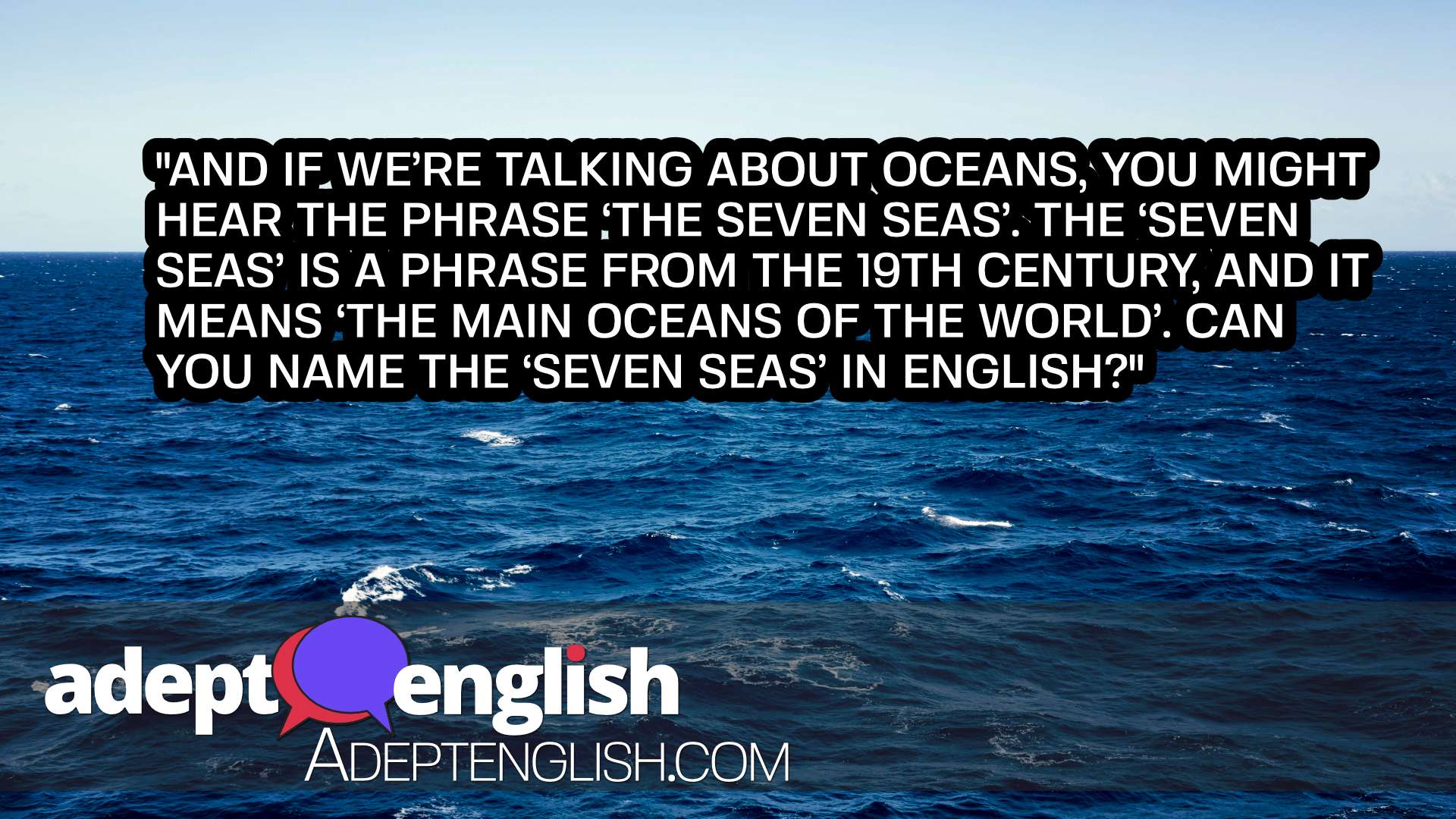English Speaking - Everyday Geography Terms And Phrases
The more you listen to the news, the more you hear about climate change and people speaking in English about geography. Mostly at a high level about the planet Earth and its oceans. So today we practice English speaking with geography phrases and vocabulary.
Geography is a huge topic and we are only going to scratch the surface of the English terms and phrases commonly used, but we have to start somewhere, right? So the next time you hear someone talk about the equator or the pacific ocean in English, you can follow the conversation.
With Adept English speaking podcast lessons, we want you to do a little more than just listen. Start by listening to the lesson several times. Then when it’s a good time for you, try mimicking what I say, listen to a sentence, then try to say it yourself out aloud. If you find it difficult to listen to yourself while you listen to me, try to record what you say on your mobile phone. You can then listen to your recordings and mine.
Speaking out and actually making a noise is an important part of converting the language learning model you’ve been building in your brain from listening (input) to speaking (output) English. You need to train the listening model to work in reverse and convert the thoughts you have into English words and not just in your mind! You need to train your brain to use your physical vocal cords and neck/mouth muscles.
Most Unusual Words:
Geography
Muscles
Mimicking
Equator
Globe
Ocean
Atlantic
Continent
Hemispheres
Most common 3 word phrases:
| Phrase | Count |
|---|---|
| And A Globe | 2 |
| The Whole World | 2 |
| On Its Surface | 2 |
| You Might Buy | 2 |
| To Give You | 2 |
Listen To The Audio Lesson Now
The mp3 audio and pdf transcript for this lesson is now part of the Adept English back catalogue . You can still download and listen to this lesson as part of one of our podcast bundles.Transcript: World Geography English Speaking Terms And Phrases Practice
Hi and welcome to this podcast from Adept English. Our podcasts are free English lessons, using our Adept English ‘Listen & Learn’ technique. If you like what we’re doing, then please help us out by giving us a star rating or a review. This is a way of supporting Adept English, even if you don’t buy our courses, because this helps other English language learners to find us online! Thankyou for doing that!
From time to time on the podcast, I will cover a topic just to give you some new words and vocabulary for a particular topic area. Sometimes I do that by covering something in the news or a new scientific discovery. Sometimes I do that as here, where it’s more like one of your English lessons, but you learn new vocabulary through listening – and repeat listening!
Today let’s learn English with ‘words for world geography’
So what about today we cover some vocabulary about ‘the World’ – English words for ‘world geography’. So if you imagine looking at one of those globes – a ball or sphere with a map of the world on its surface. A globe, GLOBE is ‘a model of the earth’. I’m going to give you vocabulary for some of the features that you’ll see on a globe.
Maps, Atlases and Globes
So if I say the word ‘map’, MAP, that means a picture of the geography of a certain place. When Christopher Columbus landed on the continent of South America, there were no maps of it, so he thought that he’d landed in East Asia instead! Not quite.
Of course, we have maps – the whole world, the whole of the planet is represented now on maps, so it’s hard to imagine Columbus’s situation because the map of the world is so well known to us. So usually maps are printed on a piece of paper, which you can unfold to look at it – and you find maps in a book.
You might buy a ‘Road Atlas’, full of maps of a particular country that you want to explore in a car. Or you might buy an atlas, a book of maps for the whole world. So there’s another word ‘Atlas’, ATLAS, which is a book of maps. And a ‘globe’, GLOBE is the sphere, ball-shaped object – with the particular meaning here that it’s a representation of the world, the earth, with the map printed on its surface. Think of The Harlem Globetrotters – the meaning here – they’re a team who ‘trot’ or run around the globe, around the world.
Oceans and Continents
So that’s ‘map’, a 2D representation of geography and a ‘globe’ is a 3D representation of the world. And the word ‘Atlas’, a book of maps is called after the god Atlas in Greek mythology, whose job it was to hold up the world on his shoulders! Anyway, imagine yourself looking at a globe, this sphere which represents the world.
Well, of course, the first thing you would notice would be the land and the sea. So the sea, SEA is likely to be represented in blue and the land is usually represented in green, but can be other colours to show geographical features, like mountain ranges or deserts. Another word for the sea of course is the ‘ocean’, OCEAN.
And if we’re talking about oceans, you might hear the phrase ‘the Seven Seas’. The ‘Seven Seas’ is a phrase from the 19th century, and it means ‘the main oceans of the world’. Can you name the ‘Seven Seas’ in English? They may be similar names to the ones in your language, or not! They are the Arctic Ocean, the North Atlantic Ocean, the South Atlantic Ocean, the Indian Ocean, the North Pacific Ocean, the South Pacific Ocean and the Southern Ocean.
📷
A photograph of ocean off into the horizon. English speaking practice with common geography phrases and terms.
What about the land? Well, imagining that globe again, the land is generally divided into continents. So a ‘continent’, CONTINENT means one of the worlds major land masses. It can mean one big piece of land or it can include lots of islands too. So like the seas, there are seven continents. I’ve already mentioned South America and Asia. Can you name the other continents, in English? Well, the other five are North America, Africa, Antarctica, Europe and Australia.
A reminder of Course One, Activate your Listening
Just a reminder at this point, that if you would like more English lessons, more structured learning, then have a look at our Course One, Activate your Listening. This course is over 5 hours long and it includes English conversations between two speakers.
Boost Your Learning With Adept English
It helps you practise and remember important English vocabulary. The course helps people who are learning English speaking and improves your fluency. Go to our website at adeptenglish.com to find out more. Back to this podcast.
The North Pole and the South Pole
So those continents are the main landmasses and the main seas that you will see on your globe. What else is there? Well, there is a north pole and a south pole, that’s POLE. When I was really little, I did actually imagine that there was a giant pole, like a big totem pole, sticking up out of the ice.
One for the North Pole at the top of the world – and one also poking downwards at the bottom of the world, for the South Pole! What we mean by the north pole, of course - it’s right at the top of the earth – and the south pole is right at the bottom.
Between these two is the axis of the rotation of the earth. That means it’s around that line between North and South Pole that the earth rotates or turns. So that’s the earth’s axis, AXIS. So ‘to rotate’ just means ‘to turn’ and ‘a rotation’ is ‘a turn’. The North Pole is weird – it doesn’t belong to a time zone. The South Pole – that’s the coldest place on earth. And the only wildlife here is penguins, that’s PENGUIN and presumably also the fish that penguins eat – and whatever those fish eat!
The Equator and the Northern and Southern Hemispheres
What about the middle of the earth? Well, much warmer, of course. But if you imagine a line around the middle of the earth, horizontal line that’s called ‘the equator’. That’s EQUATOR. And of course, as many of you experience every day, if you live in a country near the equator, then it’s hot, hot, hot most of the time.
Unlike the poles which are freezing cold. And if you live near the equator, you also live on the part of the earth which is turning fastest. And it’s a steady 12 hours of sunlight every day of the year and your sunsets and sunrises are the quickest in the world. And above the equator – that’s the Northern Hemisphere and below the equator – that’s the Southern Hemisphere.
In the Northern Hemisphere, weather systems tend to flow from west to east. And in the Southern Hemisphere, weather systems tend to flow from east to west. And the word ‘hemisphere’? Well it’s spelt HEMISPHERE and it literally means ‘half sphere’.
Video
The Equator and Lines of Latitude
In order to map and reference different locations on the earth, we use ‘lines of longitude and latitude’. So if you think of the earth having horizontal lines, rather like a stripey T shirt, of which the equator is one, then these are called ‘lines of latitude’, LATITUDE. So these are horizontal lines, used to indicate how far north or south you are.
So the equator is 0 degrees and anything above is a number of degrees north and anything below it is a number of degrees south. Right up to the North Pole, which is 90 degrees north and right down to the south pole, which is 90 degrees south. Other lines of latitude are the Tropic of Cancer, the Arctic Circle to the north and the Tropic of Capricorn and the Antarctic Circle to the south.
The Greenwich Meridian and Lines of Longitude
Another way we think of the earth - if you divided it into vertical segments, like an orange or a satsuma (or even a Terry’s Chocolate orange if you know what one of those is?!), then these are the ‘lines of longitude’.
That’s LONGITUDE. And these ‘segments’, these pieces like an orange, have different time zones. So if you fly far enough east to west or west to east, you’ll find yourself in a different time zone. And on a long flight, you may cross several time zones. But if you fly straight south or straight north, you’ll find yourself perhaps in a very different part of the world, but bizarrely still in the same time zone.
Download The Podcast Audio & Transcript
So those are the ‘lines of longitude’. And if you take the Greenwich Meridian, which runs through London, this is a line of longitude, which we call 0 degrees. It’s rather rather like the equator, but a vertical line.
Everything east of Greenwich is the Eastern Hemisphere and everything west of Greenwich is the Western Hemisphere. And the earth is divided up into degrees also – up to 180 degrees west and 180 degrees east of the Greenwich meridian.
Do you remember the Seven Seas and the Seven Continents?
So you probably know this information already, but of course you may not know the English words for all of these familiar concepts in the geography of the world. And the words in your language may be very similar – or they may be completely different.
So we’ve covered ‘the Seven Seas’ and the seven continents – can you remember the names? And we talked about the North Pole and the South Pole and the Equator and the Greenwich Meridian. And we talked about lines of latitude and lines of longitude.
So those continents again? North America, South America, Asia, Africa, Antarctica, Europe and Australia. And the seven seas? That’s the North Atlantic, the South Atlantic, the North Pacific, the South Pacific, the Arctic Ocean, the Indian Ocean and the Southern Ocean.
Goodbye
OK, that’s enough for now. Have a lovely day. Speak to you again soon. Goodbye.














